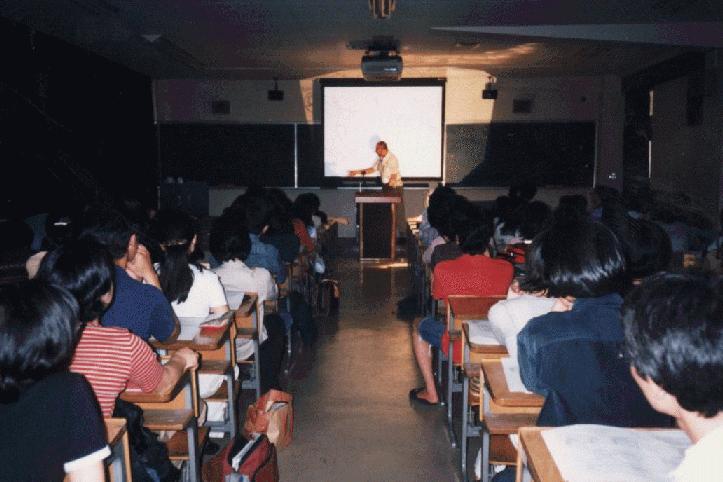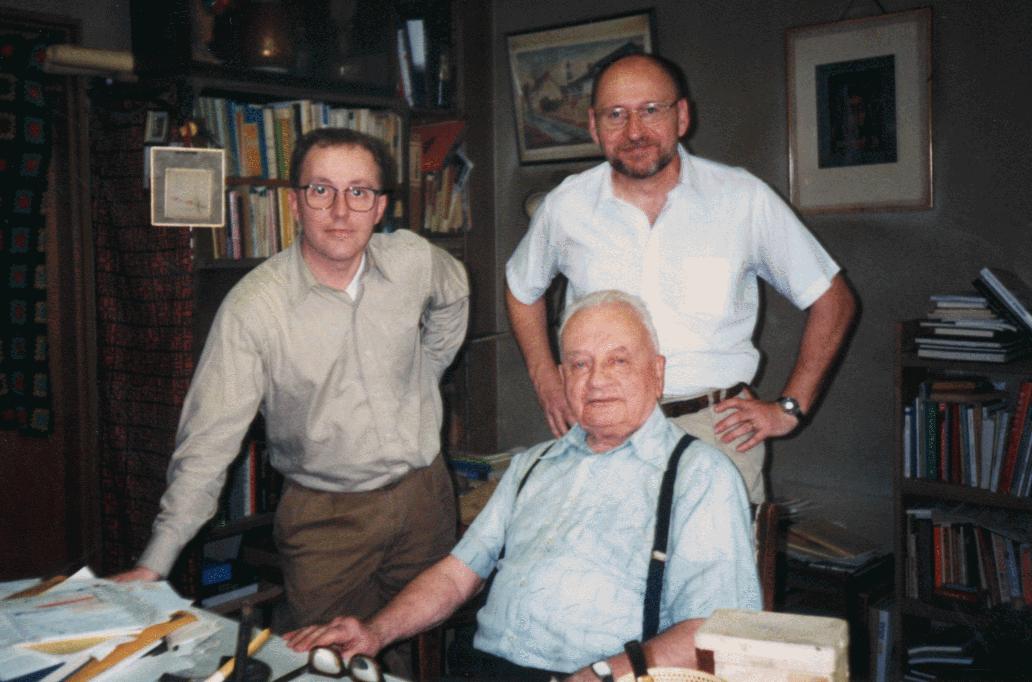The Japan Society for the Promotion of Science Research
Project S98015 "Cross Cultural Comparisons of the Perceptions of Speech Varieties"
Vistiing Scholar: Dennis R. Preston, Professor, Michigan State University
Host Scientist: Daniel Long, Associate Professor, Osaka Shoin Women's College
April 21 - May 25, 1998
Visiting Scholar Dennis Preston's Report
First, I want to express my appreciation to the Japan Society for the Promotion of Science to work with Japanese scholars in Japan. Although I have worked and cooperated with several of them over the years and have visited here briefly before, this opportunity for extended contact was particularly beneficial to me in my work on language attitudes and varieties in the United States and elsewhere (and the work of many of my students who work in the same scientific area but with a focus on Japanese). Of course, I hope that my presentations to and discussions with Japanese scholars have been beneficial to them.
A. Presentations:
1. April 23, Osaka Shoin Women's College
Lecture: Communicating across Cultures. Faculty and interested students.
Approximately twenty-five people.
In this lecture I provided a broad and somewhat nontechnical survey, not only of my work in language variation and attitudes towards language varieties but also of personal reflections on why I engage in this research. In addition to getting to know my hosts better at this presentation, I had some interesting informal contact with students who are preparing papers this term in the area of cross-cultural differences.

2. May 1, National Museum of Ethnology (Suita)
Lecture: Folk Linguistics and Ethnography. Members the Museum Study Group "Language as a Symbol in Cultural Life."
Approximately fifteen participants.
In this lecture I presented the results of research work on language perception and attitudes in the United States which my students and I and some few others have conducted. I provided a more anthropologically interpretive account of this work (as opposed to methodological and linguistically descriptive ones, as I did for other groups). In particular, I focused on the differences between Japan and the United States (and other areas) in terms of "dominating folk beliefs" (e.g., language correctness) about language, relying on both quantitative survey and qualitative discoursal data.

3. May 13, Nagoya University of Commerce and Business Administration.
Lecture: Folk Linguistics and Language Teaching and Learning. Language teaching faculty. Approximately twenty participants.
In this presentation I tried to connect the results of work in folk linguistics (or the perception of language and language variety) by nonspecialists to the importance of our knowing what such beliefs are among language learners. Although I focused on US attitudes, I tried to emphasize the importance of collecting, interpreting, and considering such folk knowledge in the teaching of languages world-wide.
4. May 16, Osaka University
Lecture: Perceptual Dialectology for Variationists. Research group on Language Variation and other interested persons. Approximately thirty participants.
In this more technical presentation, I reviewed the collection and interpretation techniques in "perceptual dialectology" (the determination of the correlation between folk and scientific belief as regards the areal distribution of language). In particular, I noted and evaluated earlier contributions by scholars from Japan and the Netherlands, work which, perhaps for language reasons alone, has not been as widely recognized as it should. In general, I tried to present a number of scientific models for fieldwork and analysis in the area of language perception by nonspecialists. I focused, in particular, on the evaluation of overarching, local folk concepts (e.g., language "correctness" in the United States) and the investigation of folk sensitivity to phonetic detail in the detection and evaluation of language varieties.

5. May 17, Benten-cho YMCA
Lecture: Folk Linguistics and Language Teaching and Learning. Members of the Osaka area JALT (Japan Association for Language Teachers) and other interested persons.
Approximately twenty persons.
This lecture was essentially the same as that presented in Nagoya at a slightly less technical level.

6. May 22, Tokyo University of Foreign Studies
Lecture: Perceptual Dialectology for Variationists. Prof. Fumio Inoue's seminar on sociolinguistics and other interested persons. Approximately 100 persons.
This lecture was essentially the same as that given in Osaka on May 16.

B. Consultations
1. During the entire period of my stay, but especially during the first three weeks, I consulted with Dr. Daniel Long (the Host Scientist) on details of the articles in my forthcoming book The Handbook of Perceptual Dialectology (Thousand Oaks, CA: Sage Publications) which were translated from Japanese and/or which touched on concerns of Japanese dialectology. This book will present for the first time in English a number or seminal works on the perception of language variety, and it was important to confirm the correctness of translation and bibliographical details.
2. I consulted with the Host Scientist over the entire period of my stay on work he is carrying out on the language contact situation in the Bonin Islands.
3. The Host Scientist and I planned, during the entire stay, a volume of articles on the perception of language differences to be drawn from work in countries not yet covered in my Handbook (mentioned above). We recruited during my stay authors from Hungary, France, Spain, Italy, Korea, Canada, and Cuba, and have sent off a book proposal to Sage Publications.
4. I consulted on phonetic research projects with Prof. Miyoko Sugito, Director of the Institute for Speech Communication Research, Nara.
Prof. Sugito gave us a tour of her research facility, and we discussed work of mutual interest. She was extremely helpful in pointing out some references from her own earlier research which will be particularly useful to my advanced graduate students who are conducting work on Japanese vowel devoicing and perceptions of the Kansai - Kanto dialect division. I was also able to advise her of the importance of making an English language version of the CD-ROM she is developing to illustrate major differences in Japanese dialects.

5. For the last two weeks of my stay, the Host Scientist and I, responding to a request from the Director of the National Center for Language Research and Education (at Michigan State University, my home institution), prepared a preliminary version of a fieldwork protocol to be used in the elicitation of folk linguistic views of language teaching and learning. The Host Scientist agreed to be the principal contact in Japan for a multi-country investigation which the Center may begin next year.
6. I met briefly with Father Willem Grootaers in Tokyo on May 22nd and discussed work in the perception of Japanese he carried out in Japan in the early 1950Åfs. This meeting clarified some important understandings about the influences on this early work which both the Host Scientist needed.

7. I toured the National Language Research Institute in Tokyo on May 22nd.
In addition to a general orientation, I met with researchers in dialect geography and discussed areas of mutual interest. I was able to offer to arrange a meeting with he president of the United States Center for Applied Linguistics for one of the Japanese Institute's Vice-Directors.
8. On May 22nd I met with Prof. Fumio Inoue of the Tokyo University of Foreign Studies, and he, and the Host Scientist, and I agreed to submit a plan for a symposium on the study of attitudes and perceptions in Japanese for the AILA (International Association for Applied Linguistics) meeting in Tokyo in August, 1999.
9. On May 24th Professor Hiroshi Tahara of the Japanese Language Research Center
at Shoin Women's College in Osaka and I discussed plans for research work on attitudes towards the Kansai - Kanto dialect division.

C. The state of research work in Japan:
My own areas of special interest (sociolinguistics, dialectology, language attitudes, ethnography of language) are all well advanced in Japan. There is no doubt that the strongest of these areas is traditional dialectology (enhanced by very sophisticated computer analyses) as evidenced by major work being done at the National Language Research Institute. Overall, I found facilities and researchers to be more than adequate in the pursuit of modern goals in sociolinguistic and ethnographic research.
Unfortunately, although it is an interest of mine, I did not get to meet with scholars who focus on discoursal or other evidence of ethnographic concerns in sociolinguistics. My impression, therefore, is only of the published work (one I had, of course, before this visit) and not worth expanding on here.

D. Other:
Finally, I would be remiss if I did not point out the cultural and personal as well as scientific importance of my stay. Although I had been in Japan briefly before, studied a little Japanese, and have many Japanese advanced graduate students, there is no other way to appreciate a culture other than living in it. My hosts at Osaka Shoin Women's College, the Host Scientist in particular, did everything possible to provide me with opportunities to enjoy and appreciate the folkways of Japan (from food to cultural and historical monuments). There is no doubt that their efforts and this opportunity enriched my life.
Dennis R. Preston
Department of Linguistics and Languages
Michigan State University
East Lansing, MI 48824
preston@pilot.msu.edu
(517) 353-0740
Å@








